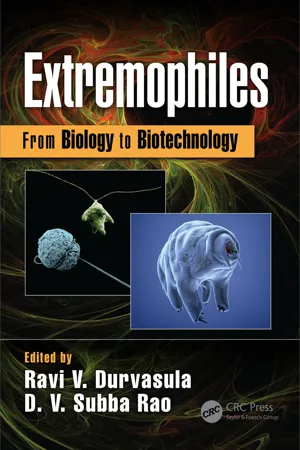
- 399 pages
- English
- ePUB (mobile friendly)
- Available on iOS & Android
About This Book
Highly recommended by CHOICE, Oct 2018
Extremophiles are nature's ultimate survivors, thriving in environments ranging from the frozen Antarctic to abyssal hot hydrothermal vents. Their lifeforms span bacteria to fishes, and are categorized as halophiles from hypersaline environments, acidophiles from acidic waters, psychrophiles from cold habitats, and thermophiles from warm waters. Extremophiles: From Biology to Biotechnology comprehensively covers the basic biology, physiology, habitats, secondary metabolites for bioprospecting, and biotechnology of these extreme survivors. The chapters focus on the novel genetic and biochemical traits that lend these organisms to biotechnological applications.
Couples studies of marine extremophile biology/genomics and extremophile culture for biotechnological applications with the latest advances in bio-prospecting and bio-product development
Includes practical experiments that a laboratory can use to replicate extreme habitats for research purposes
Presents latest advances in extremophile genomics to give the reader a better understanding of the regulatory mechanisms of extremophiles
Offers insights into the production of commercially important extremozymes, carotenoids, bioactive compounds and secondary metabolites of medicinal value.
This unique guide serves as a resource for biotechnologists who wish to explore extremophiles for their commercial potential, as well as a valuable reference for teaching undergraduate, graduate and postgraduate students.
Frequently asked questions
Information
1ExtremophilesNature’s Amazing Adapters
1.1Introduction
1.1.1Tree of Life: Extremophiles
Bacteria (Eubacteria)a | Archaeaa | Eukarya | |
|---|---|---|---|
Domain | Large domain of prokaryotes | Domain or kingdom of single-celled biota | Multicellular |
Phylogenetically | Different | Different from bacteria but similar to Eukarya | Different |
Habitat | Ubiquitous Flourished on earth for >3.5 Ga | Extreme harsh environment | Ubiquitous Appeared in the past 2 Ga |
Shape | Larger surface area to volume, leading to higher growth rate, shorter generation time | Similar to bacteria Larger surface area to volume, leading to higher growth rate, shorter generation time | Varied |
Organisms | bacteria and microorganisms | Microorganisms | Plants, animals, and microorganisms such as fungi and protists |
Cell | Single | Single | Multicellular |
Nucleus and organelles | Absent | Absent | True nucleated |
Cell | Prokaryote | Prokaryote | Eukaryote |
Cell wall | Peptidoglycan/lipopolysaccharide | Pseudopeptidoglycan Unique membrane lipids with branched fatty chains composed of repeating units of isoprene | Have cell walls, but do not contain peptidoglycan Mitochondria and chloroplasts present |
Reproduction | Asexual, binary fission, budding but form spores | Asexual, binary fission, budding | Meiosis |
Metabolism | Diverse | ||
Do not use glycolysis pathway to break down glucose Functional Krebs cycle pathway absent | |||
Protein synthesis (first amino acid formed) | Formylmethionine | Methionine | Methionine |
DNA | Mostly circular chromosome and plasmids | Circular chromosome and plasmids | Linear chromosome, rarely plasmids DNA wrapped around proteins called histones |
DNA replication, transcription, and translation | Similar to eukaryotes | ||
RNA | Complex, polymerases similar to bacteria and eukaryotes | ||
Histones | Not present | Present | Present |
Organelles | Not present | Not present | Present |
Ribosomes | 70S | 70S | 80S |
Antibiotic sensitivity | Sensitive | Not sensitiv... |
Table of contents
- Cover
- Half Title Page
- Series Page
- Front Matter Part
- Title Page
- Copyright Page
- Dedication
- Contents
- Preface
- Acknowledgments
- About the Editors
- About the Contributors
- Chapter 1 ExtremophilesNature’s Amazing Adapters
- Chapter 2 Microbial Diversity and Biotechnological Potential of Microorganisms Thriving in the Deep-Sea Brine Pools
- Chapter 3 Extremophile Diversity and Biotechnological Potential from Desert Environments and Saline Systems of Southern Tunisia
- Chapter 4 Culture Studies on a Halophile Dunaliella salina from Tropical Solar Salterns, Bay of Bengal, India
- Chapter 5 Heterotrophic Production of Phycocyanin in Galdieria sulphuraria
- Chapter 6 Biology and Applications of Halophilic and Haloalkaliphilic Actinobacteria
- Chapter 7 Adaptation Strategies in Halophilic Bacteria
- Chapter 8 Deep-Sea Vent ExtremophilesCultivation, Physiological Characteristics, and Ecological Significance
- Chapter 9 Physiological and Biochemical Adaptations of Psychrophiles
- Chapter 10 Denitrification in Extreme Environments
- Chapter 11 Extremophile Enzymes and Biotechnology
- Chapter 12 Carbonic Anhydrases of Extremophilic Microbes and Their Applicability in Mitigating Global Warming through Carbon Sequestration
- Chapter 13 Carotenoid Production in Extremophilic Microalgae and Biotechnological Implications
- Chapter 14 Secondary Metabolites from Microalgal Extremophiles and Their “Extreme-Loving” Neighbors
- Chapter 15 Medicinal Utility of Extremophiles
- Chapter 16 Extremophile Case StudiesGenomic Organization and Optimized Growth
- AppendixCulturing Extremophiles: Progress to Date
- Additional Sources of Information
- Glossary
- Index